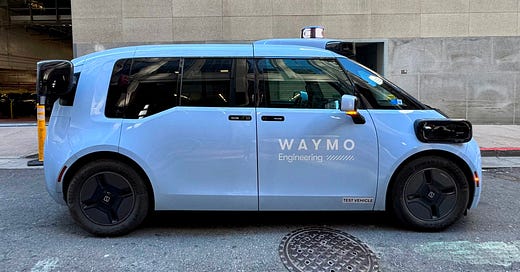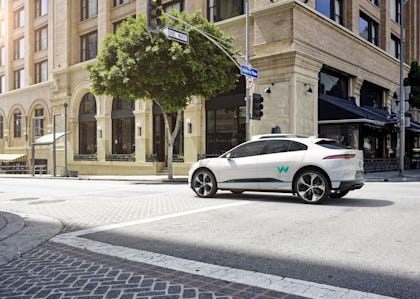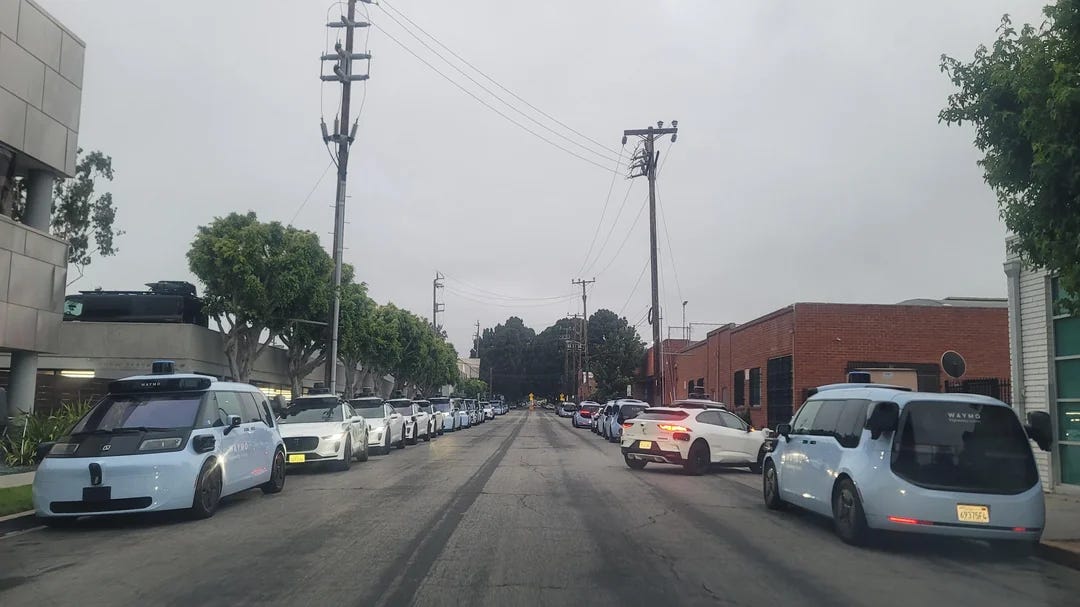The First Mass-Produced Robotaxi Is Here
Some thoughts on Waymo's new Zeekr RT and what it could mean for the autonomous car industry

Waymo has a problem. They have a great product — a self driving taxi that people love to ride, and even prefer to Uber — but they need a lot of custom vehicles to meet demand as they scale up to new cities.
Their existing fleet is based on the Jaguar I-Pace. The I-Pace is a sleek electric crossover SUV, a great looking car for 1-2 people to ride in, but it’s quite expensive. The I-Pace itself costs about $70,000 in the United States. Estimates have varied, but it’s believed they cost somewhere around $150,000 per vehicle right now, with some estimates higher.
Enter the Zeekr RT, the world’s first mass-produced, purpose-built robotaxi. Like the Jaguars, these will be integrated in the United States, at the Waymo plant in Mesa, Arizona. And they’re already being tested on city streets.
How Much Does It Cost?
The Zeekr RT is based on a Chinese minivan - the Zeekr Max - which costs about $40,000. But on top of that base model, Waymo adds a bunch of sensors:
13 RGB cameras
Four lidars
Six radars
an array of external speakers
The sensor pods are all designed to be self-cleaning as well, important when the vehicles are expected to start picking up passengers as soon as 30 mins after rolling out of the factory.

High quality lidars are much cheaper than they used to be - this might be as little as $1000 per unit, or even less. Waymo, after all, has been working on its own lidar units designed for mass production.
Automotive radars and cameras are even cheaper, on the order of hundreds of dollars per unit or less. The main costs, then, are probably integration and compute — neither of which should be cheap, exactly, but not extravagant either.
The Waymo Driver is a modular system making use of many different sensors: it won’t need as massive a neural network as we see from various foundation modeling approaches. Sensors, after all, serve as a sort of dedicated, single-role compute: rather than neural networks needing to implicitly estimate distance, the lidar just does it, and the signal only needs to be integrated.
So let’s budget as follows:
$40,000 for the Zeekr MIX upon which this vehicle is based. Source
$10,000 for sensors (number basically made up, could be much lower - backed up by Bloomberg as reported on Reddit which estimated $9,300)
$14,000 for compute (based on the price of a Lambda CoreML workstation with 2x NVIDIA 5090; source)
An extra $10,000 for integration costs (actually putting the vehicle together)
So I am guessing about $75,000 for the total price of the vehicle, including the vehicle itself, sensors, compute, etc. This lines up with at least some other estimates that I’ve seen floating around online, although nothing really official.
Now, some notes:
I do not think Waymo is actually paying $14,000 for compute. The rig I picked out with two NVIDIA 5090s is a beast of a machine, but Waymo is using Google’s TPUs, which it should be able to get cheaper. It also probably doesn’t need as much compute as I budgeted per vehicle.
Likewise, Waymo has been developing its own in-house lidars for over 10 years now, which are rumored to be very cost effective. Sensor costs could be a slight overestimate.
On the other hand, tariffs might drive up the vehicle price by a lot; and I really don’t know how expensive integration will be.
Compare to the previous version of the vehicle. The Waymo Jaguar iPace is believed to cost around $150,000 per car, potentially with slightly positive unit economics even still. That implies that Waymo will be making about $75,000 in profit in the first year with these new, much cheaper vehicles.
These new cars have been showing up in San Francisco already, and Waymo is planning to add 2,000 new vehicles going into 2026.
What does it mean?
For consumers, this means that there’s huge potential for transportation to get a lot cheap (at least in Waymo-friendly cities). This, of course, is predicated on their being actual competition in the self-driving taxi space: robotaxis seem to be a preferable service to Uber and Lyft, in no small part because there’s no human driver in the vehicle, and so prices are naturally going to be higher unless there’s competition.
So let’s talk about that competition.
Self-Driving Taxis Scale Up
Self-driving car company Wayve is doing something big: for the first time they will deploy an autonomous taxi service in London, according to CEO Alex Kendall on X. With this announcement, they join Tesla and Waymo as companies with immanen…
Tesla has recently started its own robotaxi testing in Austin, a huge step for the company. Initially, this testing is relatively restricted; the program seems to get about 500 miles per disengagement, vs. Waymo’s 14,000+. It is geofenced to a relatively small part of Austin.
But there are things to like as well: Tesla is more vertically integrated, building its own fleet of vehicles in-house, and has taken many ruthless cost-cutting measures like removing radars and lidars. If a company is going to start a price war and drive the cost of consumer transportation down to near-zero, it will be Tesla. And their autopilot program, while very behind, has been making tremendous strides lately.
I like to be optimistic and hope both companies succeed here, although Waymo has a chance to build itself a huge userbase and broad social acceptance, despite some recent bizarre counter-arguments. And of course the Tesla Cybercab could easily end up being the second mass-produced robotaxi, with a much lower price tag (likely $20,000-$25,000).
Personally, I’m eagerly watching Waymo deployments in places like New York City. In my opinion this is a critical test of the vehicles’ capabilities: not only will they have to deal with a crowded, chaotic metropolis, but with miserable East Coast weather in all its many variations. Iif these vehicles can prove themselves in hectic, dense New York City. then things will really take off.







I saw this reposted elsewhere but thought I'd comment here directly and get your feedback if any. I thought your analysis was VERY GOOD.
* The vehicle was originally designed cooperatively with Waymo back in 2020
* The original hard point vehicle was adapted by Zeekr into the Zeekr MIX in 2023
* The MIX is a very high content vehicle and baselines in CHN @ $38K.
* The decontented RT for Waymo is likely significantly less cost perhaps closer to $32-$33K
* The automated seat rails, leather throughout and lounger seats with massage in the back for example are not included
* Furthermore, because of the Biden-era ruling about Russian and Chinese cars, much of the add-on cameras and other tech are also removed
* Waymo applied for a Commerce Dept exemption from the tariffs as a B2B purchase and a hardship since Jaguar plant was torn down. Who knows how that turns out
* You should probably consider the shipping cost to get it to the US from Ningbo. It could get loaded on shipments for Polestar & Volvo which are also Geely properties
* The Zeekr RT is REPORTEDLY plug-n-play
* Not having to do retrofits for wiring, cabling, power, etcetera is the big Kitting reduction
* The designed in drive by wire makes adaptation to Robotaxi service trivial which is a BIG SAVINGS in integration.
Although Waymo and Tesla are first out of the shoot, I predict that Amazon's Zoox will overtake both, once their vehicles start hitting the road.